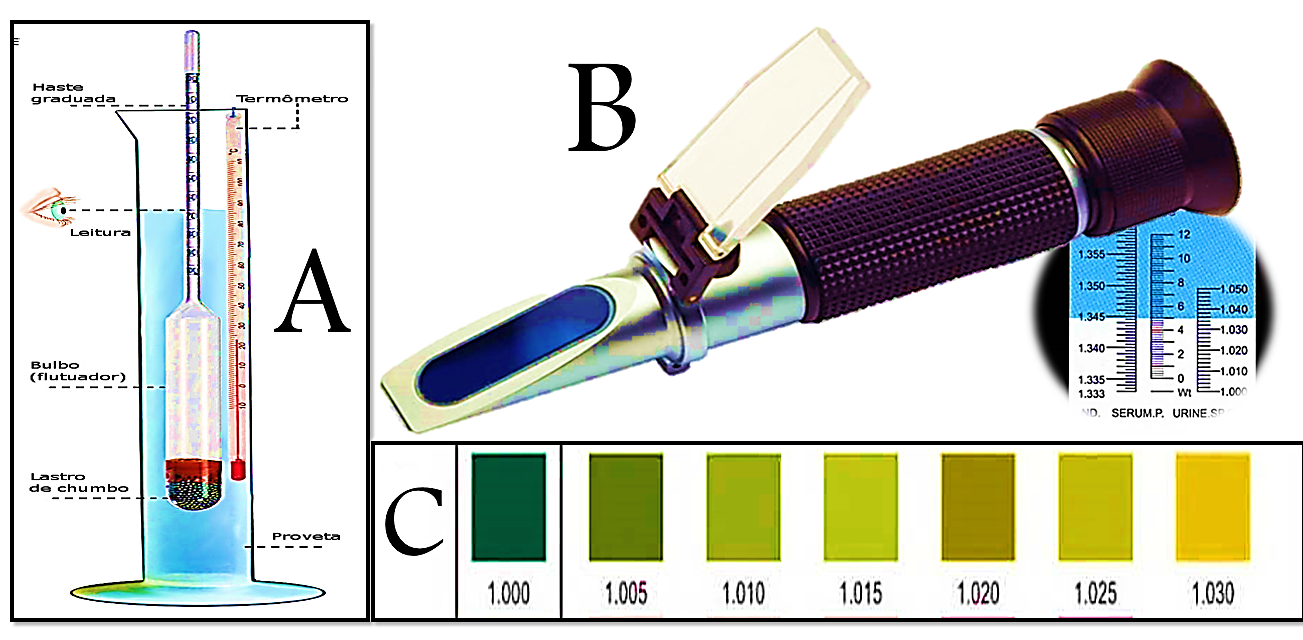CARTA AL EDITOR
REVISTA DE LA FACULTAD DE MEDICINA HUMANA 2020 - Universidad Ricardo PalmaDOI 10.25176/RFMH.v20i4.3201
URINE DENSITY, 1025 or 1.025 g / ml?
DENSIDAD DE LA ORINA ¿1025 o 1,025 g/ml?
Luis Eduardo Traviezo-Valles1,a
1 Universidad Centroccidental “Lisandro Alvarado”, Decanato de Ciencias de la Salud, Barquisimeto, Venezuela.
a Profesor titular de Parasitología Médica - orcid.org/0000-0003-4544-6965
Reading with interest a clinical case published in the Journal of the Faculty of Human Medicine entitled, primary amyloidosis(1), the report of the patient's urine density was appreciated as 1000 (thousand and without decimals), when the correct thing should be 1,000 g / mL (one gram per milliliter). This is a persistent error in health workers from Venezuela and other Latin American countries, so it is appropriate to remember the following elements:
Density (ρ) is a scalar magnitude that relates to the amount of mass (g) that presents a specific volume (mL). This principle was first described by Archimedes, who, to authenticate the King's golden crown and not destroy it in the process, immersed it in a container of water and noted the volume of water displaced (overflowed), then compared the displacement of the volume of water. Still, this time adding gold coins (compact shape), which should be the same weight of the crown (irregular shape) if the Crown did not have other different alloys inside it(2-5).
From this we have that density is the expression of mass/volume, so the International System of Units refers that these must be kilogram per cubic meter (kg / m³), gram per cubic centimeter (g / cm³), kilogram per liter (kg / L), such that for example water (universal reference) will have a density of 1 kg / L (1000 g /dm³ = 1 g /cm³ = 1 g /mL = 1 g / ml). Being the elements with the highest density of Dmitri Mendeleiev's periodic table, Osmium, Os (22.59 g/mL) and Iridium, Ir (22.56 g/mL), recalling that the radioactive elements are denser, such as Hassium, Hs (40.7 g/mL) but in turn are very unstable and difficult to measure under normal conditions(2-4).
For uro densitometry in clinical laboratories, three techniques are normally used a) Urodensitometer, a minimum of 20 mL of urine is needed where the densitometer is allowed to float without touching the walls of the tube. B) refractometer that requires only one drop of urine, and measures the refractive index with the help of a prism. C) test strips, based on the change of pKa of certain polyelectrolytes, related to the ionic concentration of urine, which is related to the specific weight, in such a way that it produces a color change in a pH indicator (Figure 1). It should be noted that test strips are the least reliable method(3,4).

Figure 1. Instruments to determine urinary density. A. Urodensimeter. B. Refractometer.. C. Test strip colors (g/mL).
There is another common element of confusion in the urinary density report, where it uses the period (.) Instead of the comma (,) to separate the integer from the fractions. This problem has been generalized from the use of test strips that mostly come from the United States, where they use the Anglo-Saxon nomenclature who separates integers from decimals with the point. Latin American users must correct this. The correct interpretation of the report is not exempted. The density should never be much greater than 1,030 g / mL, one gram plus thirty-hundredths of a gram per milliliter, which is very different to 1,030 g / mL that read as one thousand and thirty grams per milliliter. The correct thing to do in most Latin American countries is to use our measurement systems to avoid misinterpretation(1,5).
What would be equivalent? if we have an English car in Venezuela or Peru with the steering wheel on the right side, it would be compulsory to drive on the left on national roads.
Reinforcing the aforementioned, although both the Royal Academy of the Spanish Language and the International Office of Weights and Measures, decided to admit both signs to separate integers from decimals (unification), there are other rules that require only the comma (,) as the only decimal and integer separation sign in all languages(1,5).
England and its former colonies such as the United States, Australia, and India, use the point as a decimal separator. In contrast, the use of the comma is considered the norm in most countries, such as Albania, Germany, Andorra, Argentina, Austria, Azerbaijan, Belarus, Belgium, Bolivia, Bosnia, Brazil, Bulgaria, Cameroon, Canada (French-speaking), Chile, Cyprus, Colombia, Costa Rica, Croatia, Cuba, Denmark, Ecuador, Slovakia, Slovenia, Spain, Estonia, Finland, France, Greece, Greenland, Equatorial Guinea, Hungary, Indonesia, Iceland, Italy, Latvia, Lithuania, Luxembourg, Moldova, Mongolia, Norway, Netherlands, Paraguay, Peru, Poland, Portugal, Czech Republic, Romania, Russia, Serbia, South Africa, Sweden, Switzerland, Turkey, Ukraine, Uruguay, Venezuela and Zimbabwe(1,5).
Each person can confirm this on their computer, where according to the regional configuration, the calculator will use the comma or the point as a decimal separator, according to the selected country(5).
In such a way that it should help to disseminate that when a report of results of a patient with a urinary density expressed as 1025 or 1.025 or 1.025 g / ml appears in Latin America, the correct thing will be 1.025 g / ml(1-5).
Author’s contributions: The author made the generation, collection of information, writing, and final version of the original article.
Funding: Self-financed.
Conflict of interest: The author declares no conflicts of interest in the publication of this article.
Received: August 24, 2020
Approved:: September 25, 2020
Correspondence:: Luis Traviezo Valles.
Address:: Sección de Parasitología Médica. Avenida Libertador con Av. Andrés Bello, Barquisimeto-Venezuela.
Telephone number: (58) 414 5244736
E-mail: luisetraviezo@hotmail.com
BIBLIOGRAPHIC REFERENCES
